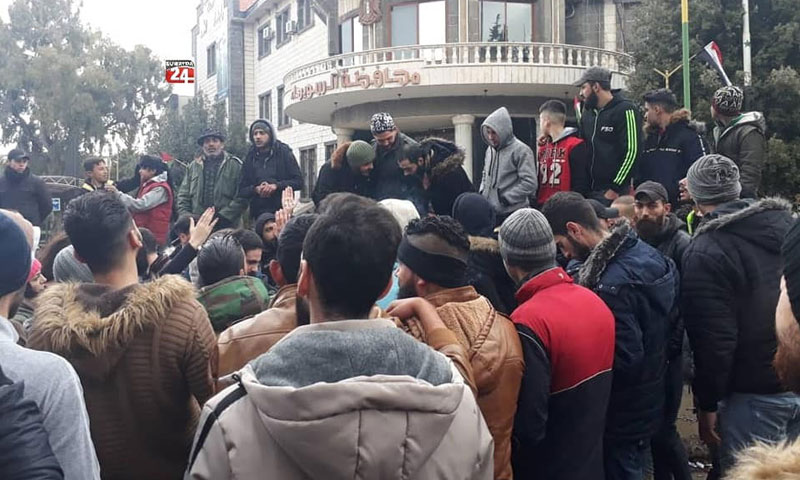Over the last few days, the governorate of Suwaida has seen several movements opposing the Syrian regime’s economic and political policies.
what is happening?
These movements started with photos circulated by social media activists on 8 January, of graffiti written on the walls of Suwaida, revealing the names of Syrian uprising martyrs and calling for the release of detained and kidnapped persons.
These graffiti were followed by demonstrations staged by some residents of Suwaida governorate against the high prices and increasingly difficult living conditions in the governorate, the state-run Syrian Arab News Agency (SANA) reported on 15 January.
A few dozens citizens gathered in front of the governorate building and blocked the road leading to the main square in the city of Shahba, according to the Sweida 24 news site.
The protesters also stood in front of the Syriatel telecommunications company owned by Rami Makhlouf, a wealthy businessman and the cousin of Syrian regime leader Bashar al-Assad.
The Syrian Pound (SYP) hit a record low against the US dollar (USD) on Saturday, 18 January, to reach 1170 SYP per USD to buy and 1210 SYP per USD to sell, according to the website of Syrian Pound Today (a Syrian Pound tracking website).
The depreciation of the Syrian Pound has caused a steep rise in food prices and led to the loss of some food products in the markets of Damascus and the Syrian-regime controlled areas, according to some information monitored by Enab Baladi via its social media networks and from local sources.
The demonstrations, under the slogan “we want to live,” were occurring on an almost daily basis until the time of writing this report on 18 January.
Why is Suwaida protesting?…for political demands or civil service reforms?
The official Spokesperson of the Syrian High Negotiations Committee (HNC), who is from the province of Suwaida, Yahia al-Aridi, thinks that the root cause of the protests is that the people of Suwaida took to the streets to reclaim their legitimate rights, describing the protestors as “conscious, patriotic youth with high morals.”
Murad, in an interview with Enab Baladi, believes that the demands of the protesters are “purely economical.” Murad points out that the people of Suwaida “ are not politically motivated or aligned. They do not belong to the Syrian opposition forces in the typical political meaning found in the short-term Syrian memory. But in return, they are explicitly protesting against corruption, its effects and the conduct of public authorities.”
There has been a wide debate about the protests and their nature on social media platforms. Some activists named the protests the “hungry revolution,” which al-Aridi denies to Enab Baladi, as he says that the demonstrators want to live “in peace, security, and stability within their country.”
However, Murad indicates a division over the broad headlines among the protesters. He stresses that these demonstrations emerged from the womb of the “class warfare”, in his view, and this type of warfare drives history.
Will demonstrations extend across other Syrian governorates?
Enab Baladi monitored sympathy between Syrians residing in the Syrian-regime controlled areas with the demonstrators, which gives rise to questions about the impact of these demonstrations on the Syrian reality in the near-term, and pushed other Syrian governorates to protest, as happened in neighboring countries.
Murad considers that if “ these demonstrations are expected to last for a few more days, there will be a kind of response in different areas,” while al-Aridi says that the most significant historical events in the history of human communities have been created by similar movements, emphasizing that the Syrian regime is in a “big trouble.”
83 percent of Syrian people live under the poverty line, according to Syria’s UN needs assessment for 2019.
As the Syrian Pound’s unofficial exchange rate has declined sharply against the US dollar, the prices of goods in the markets increase rapidly, amid failed attempts by the government to control the prices.
Suwaida has already been involved in popular protests, calling for mass reforms and the downfall of the Syrian regime, and began with the sit-in of the Bar Association on 28 March 2011. In April 2011, some educated people held demonstrations in the city as well.
Then, the demonstrations extended to take place in al-Qaria, Salkhad, Shahaba and other towns and villages in the governorate, followed by arrests of scores of activists and demonstrators made by the security branches especially between 2011 and 2012.











